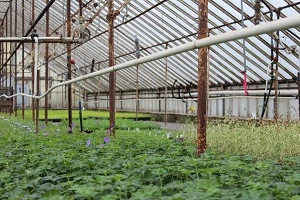
 Maximizing the efficiency of crop water application is a practical way to extend finite water supplies. Increasing water efficiency, so plants use most or all of the water applied, minimizes leaching of agrichemicals out of containers and into the environment. This reduces energy (i.e. electric) and other inputs used to move, filter and treat irrigation water before use or reapplication. Placing the correct amount of water directly on the intended crop also increases the profitability of your operation, via enhanced resource efficiency (water, energy, fertilizer and herbicide). Taking the initiative to increase water use efficiency now is a proactive step toward meeting the water availability and regulation challenges of the future.
Maximizing the efficiency of crop water application is a practical way to extend finite water supplies. Increasing water efficiency, so plants use most or all of the water applied, minimizes leaching of agrichemicals out of containers and into the environment. This reduces energy (i.e. electric) and other inputs used to move, filter and treat irrigation water before use or reapplication. Placing the correct amount of water directly on the intended crop also increases the profitability of your operation, via enhanced resource efficiency (water, energy, fertilizer and herbicide). Taking the initiative to increase water use efficiency now is a proactive step toward meeting the water availability and regulation challenges of the future.
Irrigation design
Water-use efficiency begins with irrigation design. The first choice is that of application method, whether boom, sub-irrigation, drip or micro-irrigation (i.e. spray stakes) etc. Boom, drip or micro-irrigation systems apply water directly to the container substrate and are the most efficient in terms of water application. However, these systems typically require high quality water and higher time inputs for management and maintenance. Investing in high-efficiency irrigation reduces both the total volume pumped, and the volume pumped at any one time, resulting in lower capacity demand or being able to irrigate more areas at a given time. Overhead irrigation is economical in some operations for smaller container sizes (<3 gallon), as plant densities and interception efficiencies are relatively high. Overhead systems should provide head-to-head coverage using partial and full arc heads, with matched precipitation rates (the same amount of water is applied regardless of arc), minimizing water application to roads and non-crop areas. Ideally, risers should be no higher than six feet and sized to produce larger droplet sizes that reduce the impact of wind and evaporation.
Maintenance
The next step in efficient irrigation is regular maintenance and audits of your irrigation system. Maintenance entails routine maintenance, confirming emitters and spray-stakes are working properly, checking orifice sizes and replacing worn nozzles on overhead sprinkler, monitoring pressure and keeping a running log of water meters to locate hidden leaks. Performing irrigation audits is more time-intensive and can be done at slower times of the year. A system assessment (audit) begins with a system in good working order, as outlined above. A free tutorial on running an irrigation audit can be found at www.waternut.org/moodle (“Irrigation System Audits” under “Management Tools”). Uniformity audits can be evaluated on a drip, boom, microsprinkler or overhead irrigation system, and will give you an idea of irrigation application efficiency in a given production area. The more uniform your irrigation system is within a block, the less time you need to irrigate the driest area to ensure the crop is adequately watered.
 Acceptable uniformity is 80 percent or greater. For example, let’s assume that you have to run your irrigation system for an extra 30 minutes to get the driest 30 percent of your block wet. During those 30 minutes, you are wasting water for 70 percent of your block. By increasing your uniformity, you are saving water on the 70 percent of your block that you were initially over-watering. Inefficient irrigation (over-applying, under-applying, or misapplying) does not just waste water.
Acceptable uniformity is 80 percent or greater. For example, let’s assume that you have to run your irrigation system for an extra 30 minutes to get the driest 30 percent of your block wet. During those 30 minutes, you are wasting water for 70 percent of your block. By increasing your uniformity, you are saving water on the 70 percent of your block that you were initially over-watering. Inefficient irrigation (over-applying, under-applying, or misapplying) does not just waste water.
A host of additional problems can be magnified through poor water management including algae and pest-management problems, leaching fertilizers and increased disease pressure. A national irrigation survey was conducted in 2012, and growers reported testing uniformity on only 6.2 percent of the acres reported.
Proper scheduling
The last step to water efficiency is proper irrigation scheduling, applying only the amount of water that can be held in the crops’ root zone until the next irrigation event. Traditionally, irrigation scheduling is based on a mixture of knowledge and experience. Growers look for signs of wilt, feel a container’s relative weight, use a soil moisture probe, or look at the roots to estimate dryness of the soil or substrate. These methods typically only provide an approximate indication of when to water, and do not indicate how much to water (volume). Many greenhouse growers determine irrigation length based on a clock (i.e. 1 hour) or application volume based on emitter rate (typically in liters/minute). Leaching fractions (water leached ÷ total water applied) integrate production factors (e.g. crop, substrate, container size and effect of the canopy) with water application volume and provide valuable information that can improve watering efficiency by not applying more water than a substrate can hold. Recommended target leaching fractions are < 20 percent. More information on leaching fractions can be found at www.waternut.org/moodle “Best Management Practices: Overhead Irrigation” under “Irrigation Management.”
Imagine if you could quickly and easily monitor plant root-zone moisture and automatically operate DC or AC solenoids to irrigate a block of plants with the correct amount of water as needed. Some emerging technologies are available to remotely monitor real-time soil moisture levels, as well as provide weather, soil temperature, flow meter and other sensor-based data. New sensor-based systems allow for soils or substrates to be kept at a specified soil moisture level automatically, regardless of changing conditions. Research with sensor networks has determined that saving water typically has the least impact on profitability, since water costs typically only make up a small percentage of overall production costs. The SCRI-MINDS project (Managing Irrigation and Nutrition via Distributed Sensing; www.smart-farms.net/impacts) has reported increased plant growth rates and reduced production times in greenhouse and other operation types when irrigation is more in sync with actual plant requirements. Preliminary data indicate a dramatic reduction of plant losses after adoption of a sensor-driven irrigation management, likely because of reduced root disease pressure. The benefits of sensor-based irrigation management are similar to compound interest with your savings account: good decisions made on a frequent basis are likely to lead to multiple benefits, since the plant has optimal growing conditions for an extended period of time. The typical return on investment for these sensor networks have been on the order of months to less than two years, depending on the type of operation, and the value of the crop.

There are a number of ways that irrigation can be better managed, including increasing the efficiency of current systems, investing in precision irrigation systems, and using decision-based tools to irrigate based on knowledge of plant water use. Increasing efficiency can not only save you money, but it can also produce better plants with relatively small investments in time and technology.
John Majsztrik is a post-doctorate researcher at the University of Maryland, Sarah White is assistant professor, Nursery Extension Specialist at Clemson University, Jim Owen is assistant professor, Nursery Crops Virginia Polytechnic Institute and State University (Virginia Tech), and John Lea-Cox is professor and nursery research extension specialist at the University of Maryland.
If you missed the first article, please visit http://bit.ly/13Zu4Pt.

Explore the September 2013 Issue
Check out more from this issue and find your next story to read.
Latest from Greenhouse Management
- Grant awarded to test western U.S. wood species for use as wood fiber potting substrate
- Pennsylvania Horticultural Society announces 2025 Gold Medal Plant winners
- Oasis Grower Solutions announces new Southeast territory sales manager
- A nation of gardeners: A history of the British horticulture industry
- Last Word with Angela Labrum, Bailey Nurseries
- Iowa plant supplier Plantpeddler building retail complex
- This month's Greenhouse Management magazine is about native plants and sustainability
- The HC Companies, Classic Home & Garden merge as Growscape





